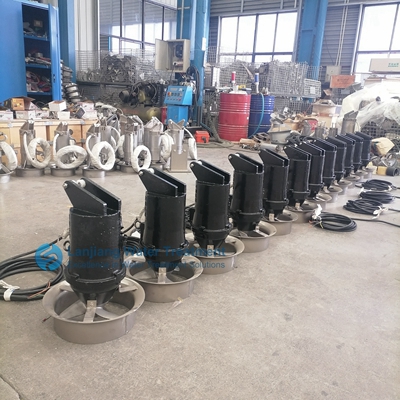Choosing the right sewage mixer is a process that takes many factors into account. Here are some key steps and considerations to help you make an informed choice:
First, clear use requirements and purposes
1. Treatment process: First of all, it is necessary to clarify the type of sewage treatment process, because different processes have different requirements for mixers. For example, a biological treatment tank may require a submersible mixer to achieve forced circulation of the water body, while an air float tank may require an air float mixer.
2. Treatment effect: Determine the desired mixing effect, such as mixing, homogenization, oxidation, etc., in order to select a mixer with corresponding functions.

Second, consider the characteristics of the mixing tank
1. Pool type: Understand the type of mixing tank, such as round, square, rectangular, etc., because the pool type will affect the selection and layout of the mixer.
2. Size: Measure the plane size, pool depth, water depth and other parameters of the mixing tank in order to choose the appropriate mixer model and power. These parameters will directly affect the stirring range and effect of the mixer.
Third, analyze the characteristics of sewage
1. Medium parameters: Understand the density, viscosity, solid content, temperature, PH and other medium parameters of sewage, which will affect the operating efficiency and mixing effect of the mixer.
2. Corrosiveness: Consider the chemical properties and corrosiveness of sewage to choose mixer materials with corresponding corrosion resistance, such as stainless steel, rubber, etc.
Fourth, choose the right type of mixer
According to the above analysis, choose the appropriate mixer type. Common types of sewage mixers include submersible mixers, mechanical mixers, air floating mixers and scraper mixers. Each type has its own characteristics and scope of application:
Submersible mixer: It is suitable for deep water areas such as biological treatment ponds, and has the advantages of simple structure, stable operation and easy operation.
Mechanical mixer: The motor drives the stirring shaft and the stirring blade to rotate, which is suitable for large and small biological treatment ponds and some small purification ponds.
Air float mixer: through the air flow to complete the mixing effect, suitable for chemical, pharmaceutical, food and other industries of the air float tank.
Scraper mixer: Through the scraper and blade to mix the bottom sludge and surface, suitable for sludge drying and other fields.
Fifth, determine the specific parameters and configuration
1. Power and speed: According to the size, depth and sewage characteristics of the mixing tank, choose the right mixer power and speed. The power directly affects the mixing capacity of the mixer, while the speed affects the mixing effect and energy consumption.
2. Impeller type and size: Select the appropriate impeller type (such as straight blade, inclined blade, curved blade, etc.) and size according to the suspension of sludge and the requirements of construction on suspended solids. The type and size of the impeller will directly affect the mixing effect and energy consumption of the mixer.
3. Protection level: Consider the protection level of the mixer, such as waterproof grade, dust grade, etc., to ensure that the mixer can operate normally under harsh environmental conditions.
Sixth, choose regular manufacturers and brands
1. Manufacturer qualification: Select mixers produced by regular manufacturers with relevant qualifications and experience to ensure product quality and after-sales service.
2. Brand reputation: Consider brand awareness and market reputation, choose brand products with good reputation.
Seventh, comprehensive consideration of costs and benefits
When choosing a sewage mixer, it is also necessary to consider the cost and use efficiency of the equipment. It is necessary to consider not only the purchase cost of the equipment, but also the operating cost and maintenance cost of the equipment. At the same time, it is necessary to ensure that the selected equipment can meet the needs of the sewage treatment process and achieve the expected treatment effect.
To sum up, the selection of the right sewage mixer needs to consider a number of factors. By clarifying the needs and purposes of the use, considering the characteristics of the mixing tank, analyzing the characteristics of the sewage, choosing the right mixer type, determining the specific parameters and configurations, selecting the regular manufacturers and brands, and considering the cost and benefits of the steps, you can help you make an informed choice.
Post time:2024-07-05